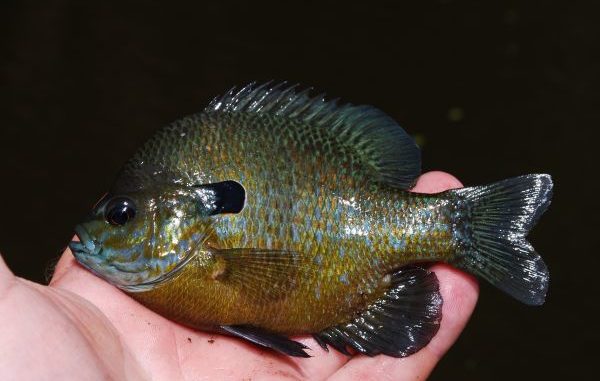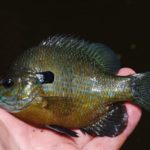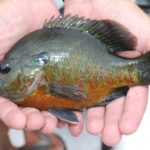
Hybridization is rampant
Hybridization, the result of cross-breeding between two species, is rare in nature. Humans can manipulate the mating of animals to produce hybrids, but Mother Nature doesn’t like that kind of fooling around.
The one family of fish where natural hybridization frequently occurs is the sunfish family, which includes black bass and bream.
On the bass side of the family, hybridization does not seem to occur often in Louisiana. Where spotted and largemouth bass occur side by side, hybrids are never seen.
On the other hand, it is not uncommon at all on the bream side of the family. In my experience, in natural waters wherever multiple species of bream exist, about 1 in 200 bream caught will be a hybrid of some sort.
Every bream species seems to be involved: bluegill, redear sunfish, goggle-eye, green sunfish (slick perch), spotted sunfish (stumpknockers), and longear sunfish and dollar sunfish, both of which fishermen lump together as “sun perch.”
Hybridization in bream probably occurs because of their spawning strategy, which seems to be similar for all species. The tidy little assumption that a male builds a nest and a single female spawns in the nest with this male, who then guards their eggs and fry, turns out to be all out of whack.
Best studied is the bluegill. Males of this species build nests by fanning bowl-shaped depressions clear of silt in water a couple of feet deep. They build their nests almost side by side in colonies (called beds) that range in number from three nests up to several hundred.
The most-desirable nests are those in the center of the bed, as they are farthest from egg-eating predators. Male bluegills fight fiercely for these spots, with the biggest fish always winning.
These males, called “parentals” by one biologist, guard their nest spot and wait for females.
When a female arrives, she can be very picky, often passing many nests before choosing one. Once she selects a mate, she tilts her body and releases a spurt of about 30 eggs into the nest. This is called “dipping.” The male showers the eggs with sperm.
This is repeated until hundreds or even thousands of eggs are laid. Then the female swims away and leaves the male to guard the nest and fan fresh water over the eggs to oxygenate them.
After about 10 days, the young bluegills scatter and the male begins preparing the nest for the next spawning. This work is tough on males, which can lose 15 percent of their body weight per spawning.
All of this sounds textbook perfect. But, as it turns out, not all males play by the rules.
A small percentage of males grow to become “cuckolders.” They mature at 2 years old instead of at 4 or 5 years like parental males.
They start their lives as “sneakers,” hanging around spawning beds, hiding behind debris and vegetation. When a female discharges her eggs, the sneaker quickly darts into the nest, releases sperm and hightails it before the large parental male can catch him.
As the sneakers age, they grow too large to hide out near nests. But instead of taking on the bright colors and behavior of parental males, they grow to look and act exactly like females.
They so resemble females that they fool parental males, which accept their presence in the nest. When a true female enters the nest and spawns with the parental male, the cuckholder gets on the other side of the female and attempts to fertilize as many of her eggs as possible.
As if these sexual shenanigans aren’t enough, a parental male will slip out of its nest and attempt (often successfully) to fertilize eggs being laid by a female in a nest next to his. On top of that, a single female will deposit her eggs in multiple nests, with some holding eggs from as many as 12 females.
Cuckholding behavior isn’t confined to bluegills, but seems to occur with all sunfish.
It is common in spotted sunfish, where sneaking and female mimicry also occurs. In one study of spotted sunfish, 33 percent of the nests had some eggs fertilized by males other than the guarding male, although the vast majority of individual eggs in the nest were fertilized by the male.
This researcher called the sneaking/female-mimicking fish “parasitic males” and the nest guarding males “bourgeois males.” Interestingly, this study showed that the number of eggs fertilized by males other than the guarding male had less to do with the number of parasitic males at the bed than with th number of nests per square yard in the bed. This leads to the conclusion that bourgeois males from nearby nests, sneaked in during spawning to fertilize some of the eggs.
Another researcher found exactly the same behavior as bluegills amongst longear sunfish (what we call sun perch or red bellies). He used the term “sneakers” for the ones that streak in to do their business, but called the female-mimickers “satellite males.”
With all of the cheating going on in the bream community, it is little surprise that a male bream of one species might deliberately or impulsively find a way to fertilize the eggs of another species of bream.
Father’s Day must result in mass confusion in the bream world.




